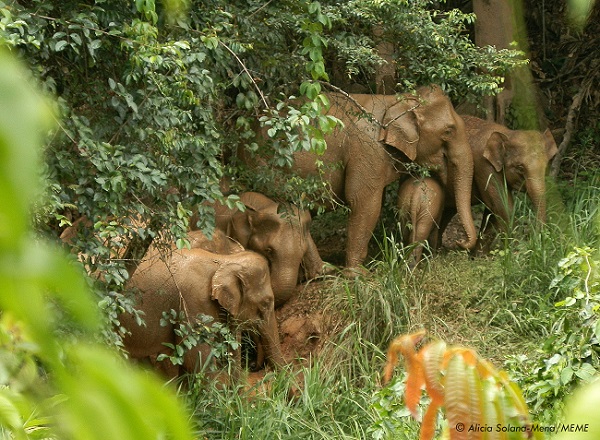
As we celebrate World Elephant Day on 12 August, here are 20 facts about these gentle giants and the steps and research that is being carried out for humans and elephants to coexist.
20 facts were chosen as this year the University of Nottingham turns 20, having been established in 2000.
- There are three living species of elephants: the Asian elephant (Elephas maximus) the African bush elephant (Loxodonta africana) and the African forest elephant (Loxodonta cyclotis).
- Elephants are known to live in matriarchal-led, close-knit social groups.
- After the great apes, elephants are considered to be the world’s most intelligent land mammal. Elephants are known to have remarkable memories. They can also make and use tools; breaking off leafy branches and using them as fly swatters.
- Elephants are sentient beings. They exhibit empathy towards other elephants who are in distress, offer protection to young or injured elephants and are capable of understanding deaths; for instance, they would stay by the dead elephant’s body and attempt to bury it.
- Wild elephants help to maintain the forest’s ecosystem dynamics by playing a vital role in seed dispersal especially for fruits with large seeds and in nutrient cycling hence known as mega-gardeners of the forest.
- Wild elephants are known as ecosystem engineers because they can modify habitats for many other animals. As they travel, they create pathways and when they dig the soil for nutrients, they create saltlicks. Some of these geological changes in the landscape can last for generations.
- Asian elephants can grow up to 2.7 metres in height with a weight of between 3,000 and 6,000 kilogrammes, while African elephants can grow up to 3 metres in height and weigh between 4,000 and 7,500 kilogrammes.
- Adult elephants can eat up to 150 kg of food a day from more than 100 species of plants. Their diet consists of plant material like bamboo, grass, leaf, bark, twig, fruit and tuber.
- Elephant dung creates mini habitats for other wildlife. It provides a good shelter for frogs and invertebrates such as beetles, ants, centipedes, millipedes, scorpions, crickets, spiders and termites.
- Elephants have the longest gestation period of all mammals; 22 months!
- Malaysia is one of the 13 remaining countries in Asia still blessed to have elephants in the wild.
- Habitat loss, poaching and human-elephant conflict are threats endangering our elephant population.
- Realising the threats and the situation that Asian elephants are facing, the Management & Ecology of Malaysian Elephants (MEME) research project based at the University of Nottingham Malaysia collaborates with the Department of Wildlife and National Parks (PERHILITAN) of Peninsular Malaysia to bring an evidence-based approach for the conservation of elephants in Malaysia.
- An elephant can poop up to 18 times in a day and produce about one tonne of dung per week. Elephant dung plays an important role in keeping the soil fertile and provides nutrients to seeds that the elephant swallows and defecates.
- MEME, together with PERHILITAN, have put GPS collars (a movement tracking device) on more than 50 wild elephants in Peninsular Malaysia to better understand their range as well as how infrastructures like roads affect their movement.
- Well-connected wildlife habitats are vital for the survival of elephants. When infrastructures such as roads cut across wildlife habitat, it becomes a barrier that prevents elephants from moving from one side to the other. Apart from that, oncoming traffic increases the risks of elephant mortality.
- According to MEME’s elephant movement data, the translocation of conflict elephants is not always effective, and, in some cases, the elephants even manage to find their way back home.
- Due to land competition and habitat fragmentation, humans will come into contact more frequently with elephants and conflict may occur. To prevent further loss of elephant range, we need to support and help farmers, so they are able to share the landscape with wild elephants (co-exist).
- The closest living relatives of elephants are the dugongs, manatees, aardvarks, and hyraxes.
- Elephants cannot jump!
(Image caption: An elephant family looking out for their young ones while feeding in the jungles of Malaysia.)
-ends-
For media enquiries please contact: Josephine Dionisappu, PR and Communications Manager University of Nottingham Malaysia at josephine.dionisappu@nottingham.edu.my
Notes to editors: The University of Nottingham is a research-intensive university with a proud heritage, consistently ranked among the world's top 100. Studying at the University of Nottingham is a life-changing experience and we pride ourselves on unlocking the potential of our 44,000 students - Nottingham was named both Sports and International University of the Year in the 2019 Times and Sunday Times Good University Guide, was awarded gold in the TEF 2017 and features in the top 20 of all three major UK rankings. We have a pioneering spirit, expressed in the vision of our founder Sir Jesse Boot, which has seen us lead the way in establishing campuses in China and Malaysia - part of a globally connected network of education, research and industrial engagement. We are ranked eighth for research power in the UK according to REF 2014. We have six beacons of research excellence helping to transform lives and change the world; we are also a major employer and industry partner - locally and globally.
Posted on 4th September 2020